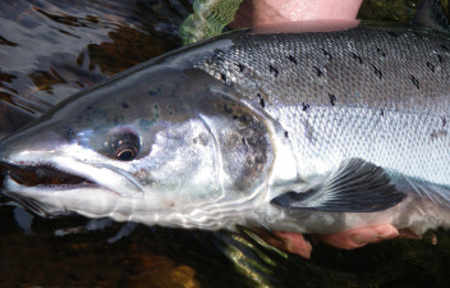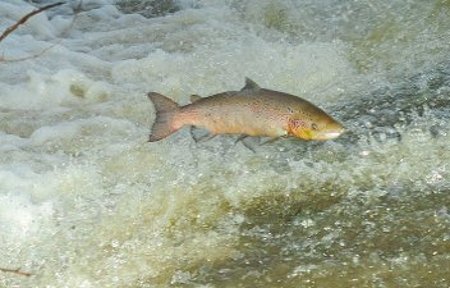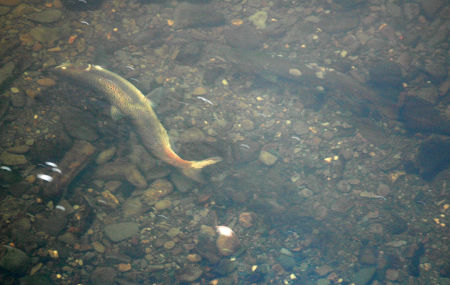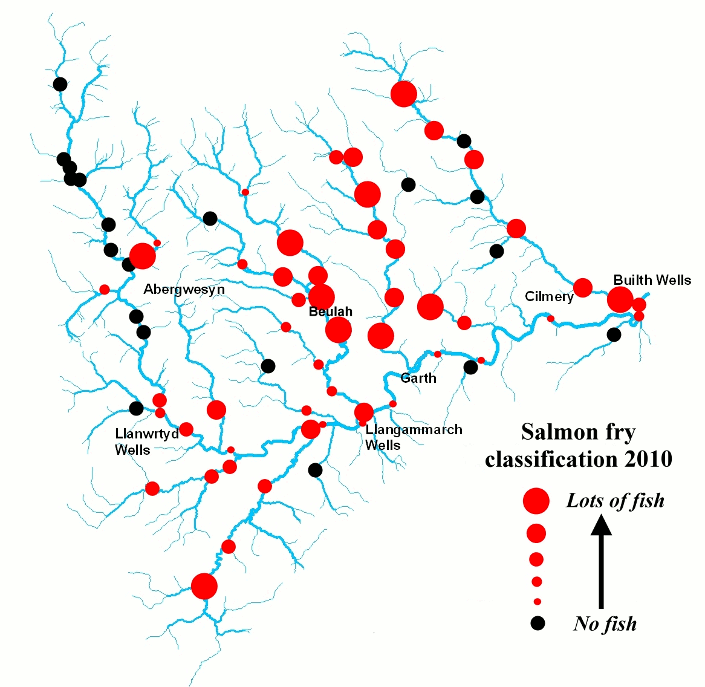The Atlantic salmon Salmo salar is an anadromous species (i.e. adults migrate from the sea to breed in freshwater). Spawning takes place in a depression in the clean gravel of the riverbed (called a redd), excavated by the hen fish in the late autumn/early winter. In spring the young fry emerge to spread out into other parts of the river (commonly up to 2km from the redd site) and compete with each other for habitat. As few as 10% survive to the next winter when population numbers are high. In their second year in freshwater they are called 'parr'. Once they have reached 120mm in length they take on a silvery colour and migrate downstream to the sea as 'smolts', usually during in April and May. Salmon have a specialised homing instinct that draws them back to spawn in the stream of their birth after 1-4 years in the sea. This behaviour has resulted in local adaptations and a stock that is genetically distinct between rivers and even between separate tributaries of large rivers. Atlantic salmon can be found across Europe from Portugal in the south to Sweden and Finland in the north. The UK salmon population comprises a significant proportion of the total European stock. The species is subject to many pressures including pollution, the introduction of non-native salmon stocks (hatchery programmes), physical barriers to migration, exploitation from netting and angling, physical degradation of spawning and nursery habitat, and increased marine mortality due to problems within the marine environment.


Rivers vary considerably in their ecological and hydrological characteristics and salmon have adapted their life-cycle strategies accordingly. There are particularly strong contrasts between southern and northern rivers and the UK's varied climate, geology and terrain means that a high diversity can be found within some of the large rivers. The cool, wet climate of the Irfon, combined with the hard rocks and steep slopes results in rivers that are nutrient-poor and prone to sudden increases in flow ('spates') in response to heavy rainfalls or sudden snow-melt. As a result, most Irfon salmon take 2 years to reach the smolt stage and migrate to sea. In recent years the recorded 1.7 degree rises in annual water temperatures as a result of climate change have extended the growing season and led to an increased proportion of juveniles smolting after only one year in the river.
Irfon Salmon & ISAC
The River Wye was once one of the greatest salmon rivers in the world and was famed particularly for the size of its fish. It is still notable for its high number (around 75% of the stock) of early running multi sea winter salmon. Between the 1970's and 2002 it suffered a continuous decline and despite a recovery in the past 8 years, stocks are still only around 15% of previous levels. This project will protect and enhance this economically valuable species.

The Irfon provides important spawning areas for Atlantic salmon and juveniles are present in good numbers throughout, except for the strongly acidic reach upstream of Llanwrtyd Wells.
The quality of the Irfon is exemplified by the fact that despite only being 6% of the Wye catchment it supports as much as 25% of the current Wye salmon stock and would be a major salmon river in its own right anywhere else in Wales.
Atlantic salmon will benefit considerably from the ISAC project. Both the acid waters work and habitat restoration will increase the survival rates of juveniles, leading to more adult fish.

